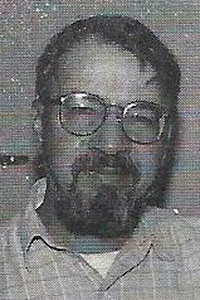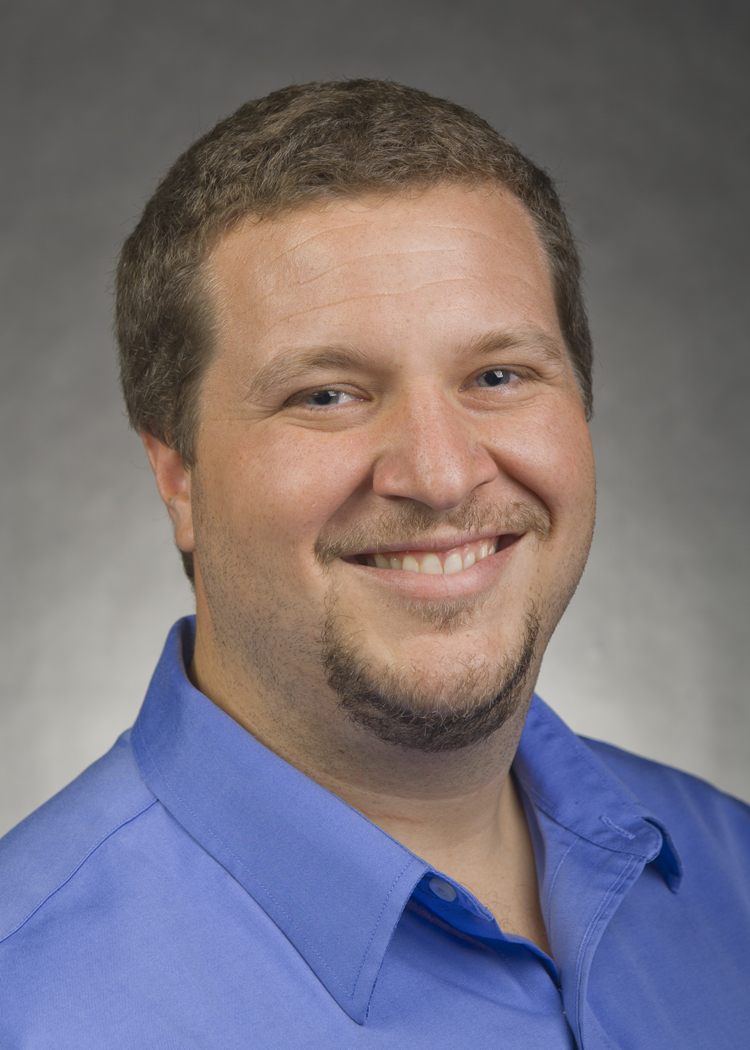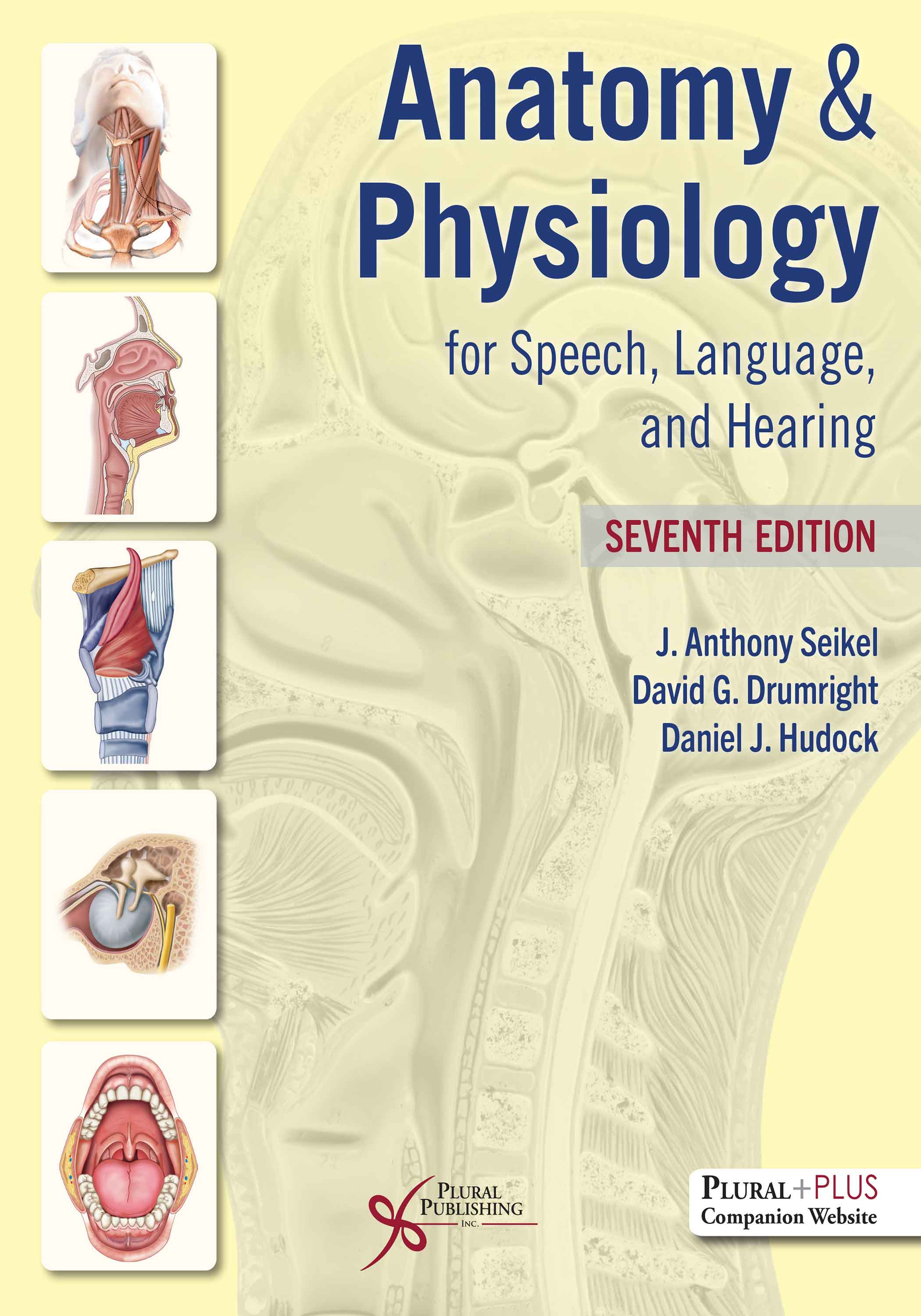
Anatomy & Physiology for Speech, Language, and Hearing
Seventh Edition
J. Anthony Seikel, David G. Drumright, Daniel J. Hudock
Details: 835 pages, Full Color, Hardcover, 8.5" x 11", with ANAQUEST study software
ISBN13: 978-1-63550-628-0
© 2025 | Available
For Instructors
Purchase
The most adopted textbook for anatomy and physiology courses in
communication sciences and disorders programs!
With many exciting enhancements and robust online resources, the seventh edition of Anatomy & Physiology for Speech, Language, and Hearing provides a solid foundation in anatomical and physiological principles relevant to the fields of speech-language pathology and audiology. The text is supported by an innovative study software program called ANAQUEST that includes interactive lessons, animations, and videos to further help students master the complex material.
This bestselling text is organized around the five “classic” systems of speech, language and hearing: the respiratory, phonatory, articulatory/resonatory, nervous, and auditory systems. Integrating clinical information with everyday experiences to reveal how anatomy and physiology relate to the speech, language, and hearing systems, the text introduces all the essential anatomy and physiology information in a carefully structured way, helping students to steadily build their knowledge and successfully apply it to clinical practice. Hundreds of dynamic, full-color illustrations and online lessons make the complex material approachable even for students with little or no background in anatomy and physiology.
Key Features
- 560+ figures and tables provide visual examples of the anatomy, processes, body systems, and data discussed. Photographs of human specimens provide a real-life look at the body parts and functions
- Chapter pedagogy includes:
- Learning objectives, call outs to related ANAQUEST lessons, bolded key terms, and chapter summaries
- Clinical notes boxes relate topics directly to clinical experience to emphasize the importance of anatomy in clinical practice
- Margin notes identify important terminology, root words, and definitions, that are highlighted in color throughout each chapter
- “To summarize” sections provide a succinct listing of the major topics covered in a chapter or chapter section
- Muscle tables describe the origin, course, insertion, innervation, and function of key muscles and muscle groups
- Glossary with 2,000+ terms and definitions
- Comprehensive bibliography in each chapter with 600+ references throughout the text
- Multiple online appendices include an alphabetical listing of anatomical terms, useful combining forms, and listings of sensors and cranial nerves
New to the Seventh Edition
- Addition of clinical cases related to neurophysiology and hearing
- Revised and updated physiology of swallowing includes discussion of postnatal development and aging effects of the swallowing mechanism and function
- Brief discussion of the basics of genetics and trait transmission
- Overview of prenatal development as it relates to the mechanisms of speech and hearing
- Presentation of prenatal and postnatal development for each of the systems of speech and hearing, as well as the effects of aging on each system
- Learning objectives have been added to the beginning of each chapter
- Chapter study questions have been moved online so students can take interactive quizzes with scores
- The helpful appendices moved online to reduce the length and weight of the print book
- For instructors, the test questions and slides have been updated and expanded
- The ANAQUEST study software has been updated with new illustrations from the text, and lessons to match the content newly added to the book
Plural Plus Online Ancillary Materials
For instructors: PowerPoint slides, Test bank, Activities/exercises, Labs, Sample syllabus, Videos, A version of the ANAQUEST software for upload to select Learning Management Systems (LMS)
For students: A web version of the ANAQUEST study software, Interactive study quizzes, Videos
Reviews
"This book is the gold standard for anatomy and physiology education in communication sciences and disorders. The authors have taken great care in offering a pedagogically thoughtful textbook for students. This edition offers many needed updates and enhancements to the previous edition, including improvements to the Anaquest software."
— Matthew H. Rouse, MS, SLPD, CCC-SLP, Biola University, in Doody's Reviews (November 2024)
Preface
About the Authors
Introduction to the Learner
Acknowledgements
Introduction to the Learner
Using This Textbook and Online Resources
Chapter 1. Basic Elements of Anatomy
Anatomy and Physiology
Terminology of Anatomy
Terms of Orientation
Terms of Movement
Parts of the Body
Building Blocks of Anatomy: Tissues and Systems
Tissues
Body Systems
Prenatal Development
Genetic Terminology
Stages of Prenatal Development
Development of Individual Systems
Chapter Summary
Bibliography
Chapter 2. Anatomy of Respiration
The Support Structure of Respiration
Overview
Vertebral Column
Pelvic and Pectoral Girdles
Ribs and Rib Cage
Soft Tissue of the Thorax and Respiratory Passageway
Divisions of the Bronchial Tree
Movement of Air Through the Respiratory System
Muscles of Inspiration
Muscles of Forced Expiration
Respiratory Muscle of the Upper Limb: Latissimus Dorsi
Chapter Summary
Bibliography
Chapter 3. Physiology of Respiration
The Flow of Respiration
Instruments in Respiration
Respiration for Life
Effects of Turbulence on Respiration
Respiratory Cycle
Lung Volumes and Capacities
Lung Volumes
Lung Capacities
Pressures of the Respiratory System
Pressures Generated by the Tissue
Effects of Posture on Speech
Pressures and Volumes of Speech
Prenatal Development of the Respiratory System
Axial skeleton Development: Vertebral Column and Rib Cage
Respiratory System Development
Postnatal Development and Aging in Respiration
Effect of Age on Volumes and Capacities
Effect of Age on Respiratory Rate
Muscle Development and Control
Physical Bases of Changes in Adulthood
Respiratory Pathologies Affecting Communication
Acute Conditions
Chronic Conditions
Chapter Summary
Bibliography
Chapter 4. Anatomy of Phonation
A Tour of the Phonatory Mechanism
Framework of the Larynx
Cavities of the Larynx
Cartilaginous Structure of the Larynx
Movement of the Cartilages
Laryngeal Musculature
Intrinsic Laryngeal Muscles
Laryngeal Elevators and Depressors
Chapter Summary
Bibliography
Chapter 5. Physiology of Phonation
Nonspeech Laryngeal Function
Laryngeal Function for Speech
A Brief Discussion of Acoustics
Instruments for Voicing
The Bernoulli Effect
Vocal Attack
Termination
Sustained Phonation
Vocal Register
Frequency, Pitch, and Pitch Change
Pitch-Changing Mechanism
Intensity and Intensity Change
Clinical Considerations
Linguistic Aspects of Pitch and Intensity
Theories of Phonation
Prenatal Development
Postnatal Development and Aging of the Phonatory Mechanism
Vocal Fold Changes
Vocal Fold Tissue Changes
Cartilage Changes
Hyoid and Laryngeal Descent
Fundamental Frequency Changes During Development
The Effects of Aging
Supportive Tissue
Muscle
Cartilages
Nerves and Sensation
Fundamental Frequency Changes With Aging
Changes in Other Acoustic Parameters
Pathologies That May Affect Phonation
Structural Etiologies
Degenerative Neurological Diseases
Chapter Summary
Decibel Practice Activity
I. Exponents and Logarithms
II. dB SPL Problems
III. SPL: More Complex Examples
IV. Decibel Increase and Decrease
Bibliography
Chapter 6. Anatomy of Articulation and Resonation
Source-Filter Theory of Vowel Production
The Articulators
Bones of the Face and Cranial Skeleton
Bones of the Face
Bones of the Cranial Skeleton
Dentition
Dental Development
Dental Occlusion
Cavities of the Articulatory System
Muscles of the Face and Mouth
Muscles of the Face
Muscles of the Mouth
Muscles of Mastication: Mandibular Elevators and Depressors
Muscles of the Pharynx
Chapter Summary
Bibliography
Chapter 7. Physiology of Articulation and Resonation
Instrumentation in Articulation
Speech Function
Lips
Mandible
Tongue
Velum
Coordinated Articulation
Central Control Theory
Dynamic or Action Theory Models
The DIVA Model of Speech Production
Prenatal Articulatory/Resonatory System Development: Pharynx, Face, and Neck
Development of the Skull
Oral Cavity and Pharynx Development
Facial Development
Postnatal Development and Aging in Articulation and Resonation
General Craniofacial Growth
Development of Articulatory Ability
Effects of Aging on Structure and Function
Pathologies That May Affect Articulation
Problems Affecting Dentition
Problems Affecting the Tongue
Mandibular and Maxillary Problems
Problems Affecting Lips and Palate
Neurogenic Conditions Affecting Speech
Chapter Summary
Bibliography
Chapter 8. Physiology of Mastication and Deglutition
Mastication and Deglutition
Instrumentation in Swallowing Function
Organizational Patterns of Mastication and Deglutition
Oral Stage: Oral Preparation
Oral Stage: Transport
Pharyngeal Stage
Esophageal Stage
Process Model of Mastication and Deglutition
Neurophysiological Underpinnings of Mastication and Deglutition
Sensation Associated with Mastication and Deglutition
Salivation Response
Anatomical and Physiological Changes in Development and Aging
Development
Changes in Swallowing With Aging
Reflexive Circuits of Mastication and Deglutition
Chewing Reflex
Orienting, Rooting, and Suckling/Sucking Reflexes
Uvular (Palatal) Reflex
Gag (Pharyngeal) Reflex
Retch and Vomit Reflex
Cough Reflex
Pain Withdrawal Reflex
Apneic Reflex
Respiration Reflexes
Swallowing Reflex
Reexamination of the Patterns for Mastication and Deglutition: A Complex Integration of Reflexes and Voluntary Action
Pathologies Affecting Swallowing Function
Chapter Summary
Bibliography
Chapter 9. Anatomy of Hearing
The Structures of Hearing
Outer Ear
Middle Ear
Landmarks of the Middle Ear
Inner Ear
Osseous Vestibule
Osseous Semicircular Canals
Osseous Cochlear Labyrinth
Membranous Labyrinth
Innervation Pattern of the Organ of Corti
Chapter Summary
Bibliography
Chapter 10. Auditory Physiology
Instrumentation in Hearing Research
Outer Ear
Middle Ear Function
Inner Ear Function
Vestibular Mechanism
Auditory Mechanism: Mechanical Events
Electrical Events
Neural Responses
Poststimulus Time Histograms
Interspike Interval and Period Histograms
Frequency Selectivity
Auditory Pathway Responses
Auditory Development and Auditory Aging
Prenatal Development
Postnatal Development of the Peripheral Auditory System
Aging and the Auditory Mechanism
Pathologies That May Affect Audition
Inflammatory Conditions
Congenital Problems
Traumatic Lesions
Neoplastic Changes
Bone Changes
Chapter Summary
Bibliography
Chapter 11. Neuroanatomy
Overview
Sense, Sensor, and Stimulation
Divisions of the Nervous System
Central Nervous System and Peripheral Nervous System
Autonomic and Somatic Nervous Systems
Development Divisions
Anatomy of the Central Nervous System and Peripheral Nervous System
Neurons
Anatomy of the Cerebrum
Medial Surface of Cerebral Cortex
Inferior Surface of Cerebral Cortex
Myelinated Fibers
Anatomy of the Subcortex
Cerebrovascular System
Cerebellum
Anatomy of the Brainstem
Cranial Nerves
Specific Cranial Nerves
Anatomy of the Spinal Cord
Pathways of the Spinal Cord
Chapter Summary
Bibliography
Chapter 12. Neurophysiology
Instrumentation in Neurophysiology
The Neuron
Neuron Function
Muscle Function
Higher Functioning
Motor System Lesions
Afferent Inputs
Association Regions
Hemispheric Specialization
Lesion Studies
Motor Control for Speech
Development and Aging of the Brain
Prenatal Development of the Nervous System
Postnatal Development of the Brain
The Aging Brain
Neurogenic Conditions That May Affect Communication
Acquired Conditions
Chapter Summary
Bibliography
Glossary
Index
The Appendices are now available online-only via the companion website.
Anatomy & Physiology for Speech, Language, and Hearing, Seventh Edition comes with access to supplementary student and instructor resources on a PluralPlus companion website.
The companion website is located at: https://www.pluralpublishing.com/publication/apslh7e
STUDENTS:
The student resources include:
- Web-version of the ANAQUEST study software
- Interactive study quizzes
- Videos
- Appendices A-H
To access the resources, you must register on the companion website and log in using the access code located in the front of your textbook. If you purchased an eBook directly from Plural accessible on the Plural eReader, the resources are accessible within the Plural eBook.
INSTRUCTORS:
The instructor resources include:
- PowerPoint slides
- Test Bank
- Class activities and labs
- Sample course syllabus
- Videos
- A version of the ANAQUEST software for use in Canvas, Moodle, and Blackboard learning management systems
You will also have access to all of the student resources listed above.
To access the instructor resources, you must contact Plural Publishing, Inc. to be verified as an instructor and receive your access code.
Email: instructormaterials@pluralpublishing.com
Tel: 866-758-7251 (toll free) or 858-492-1555
*Note for students: If you have purchased this textbook used or have rented it, your access code will not work if it was already redeemed by the original buyer of the book. Plural Publishing does not offer replacement access codes for used or rented textbooks.
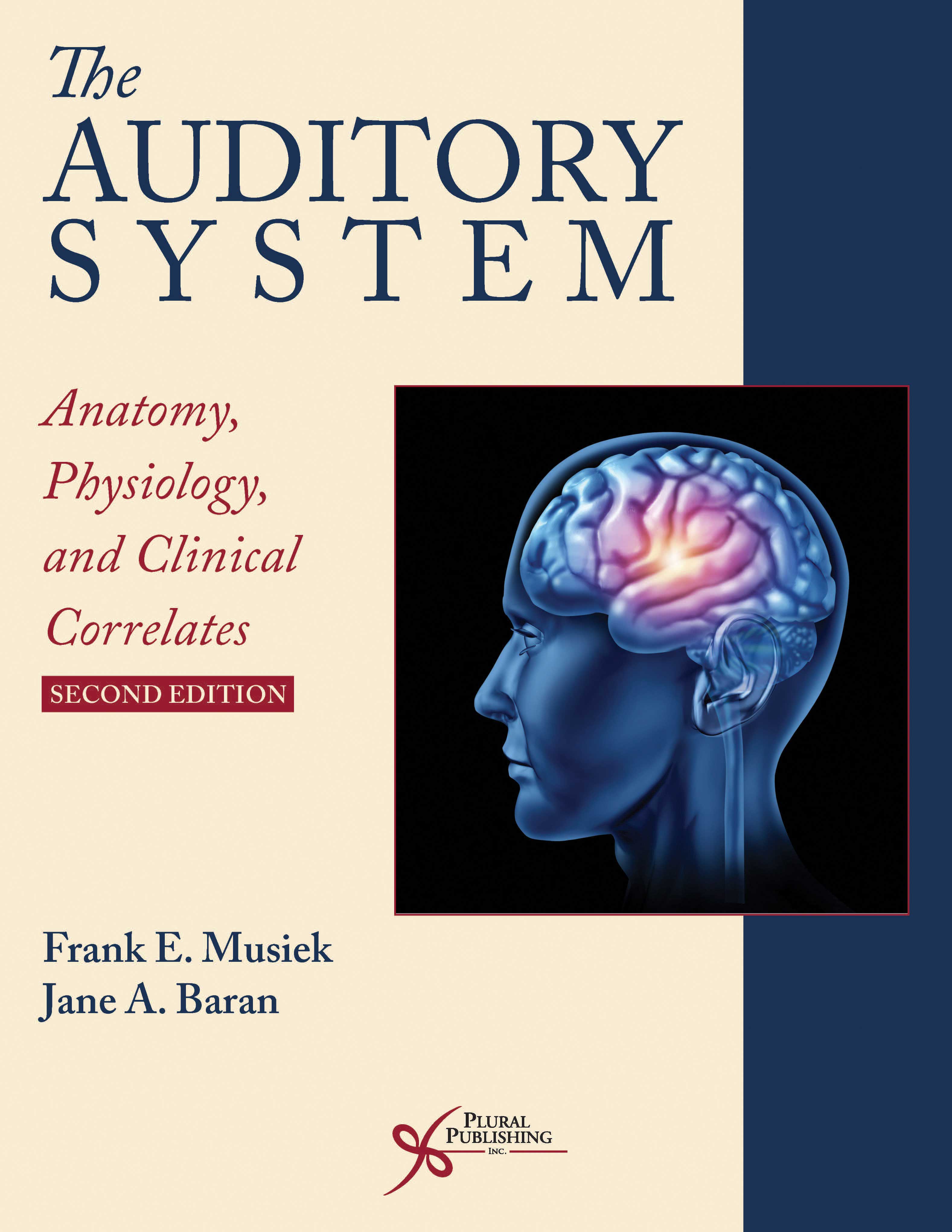
The Auditory System: Anatomy, Physiology, and Clinical Correlates
Second Edition
Frank E. Musiek, Jane A. Baran
Details: 487 pages, Full Color, Hardcover, 8.5" x 11"
ISBN13: 978-1-94488-300-3
© 2020 | Available
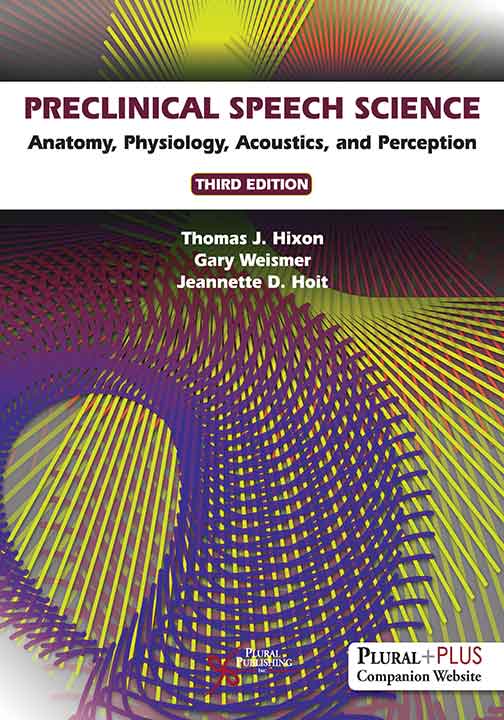
Preclinical Speech Science: Anatomy, Physiology, Acoustics, and Perception
Third Edition
Thomas J. Hixon, Gary Weismer, Jeannette D. Hoit
Details: 728 pages, Full Color, Hardcover, 8.5" x 11"
ISBN13: 978-1-63550-061-5
© 2020 | Available
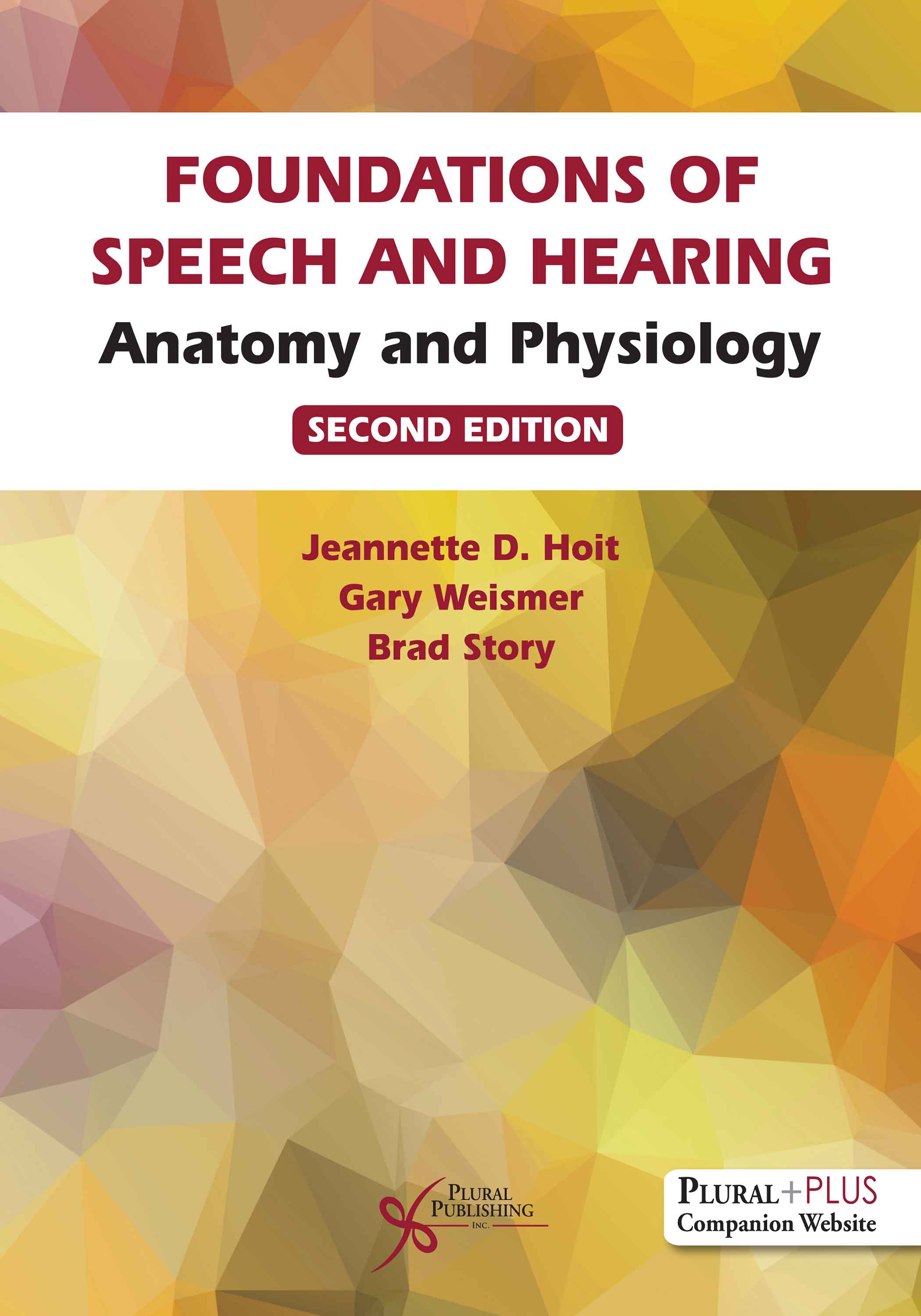
Foundations of Speech and Hearing: Anatomy and Physiology.
Second Edition
Jeannette D. Hoit, Gary Weismer, Brad H. Story
Details: 348 pages, Full Color, Hardcover, 8.5" x 11"
ISBN13: 978-1-63550-306-7
© 2022 | Available
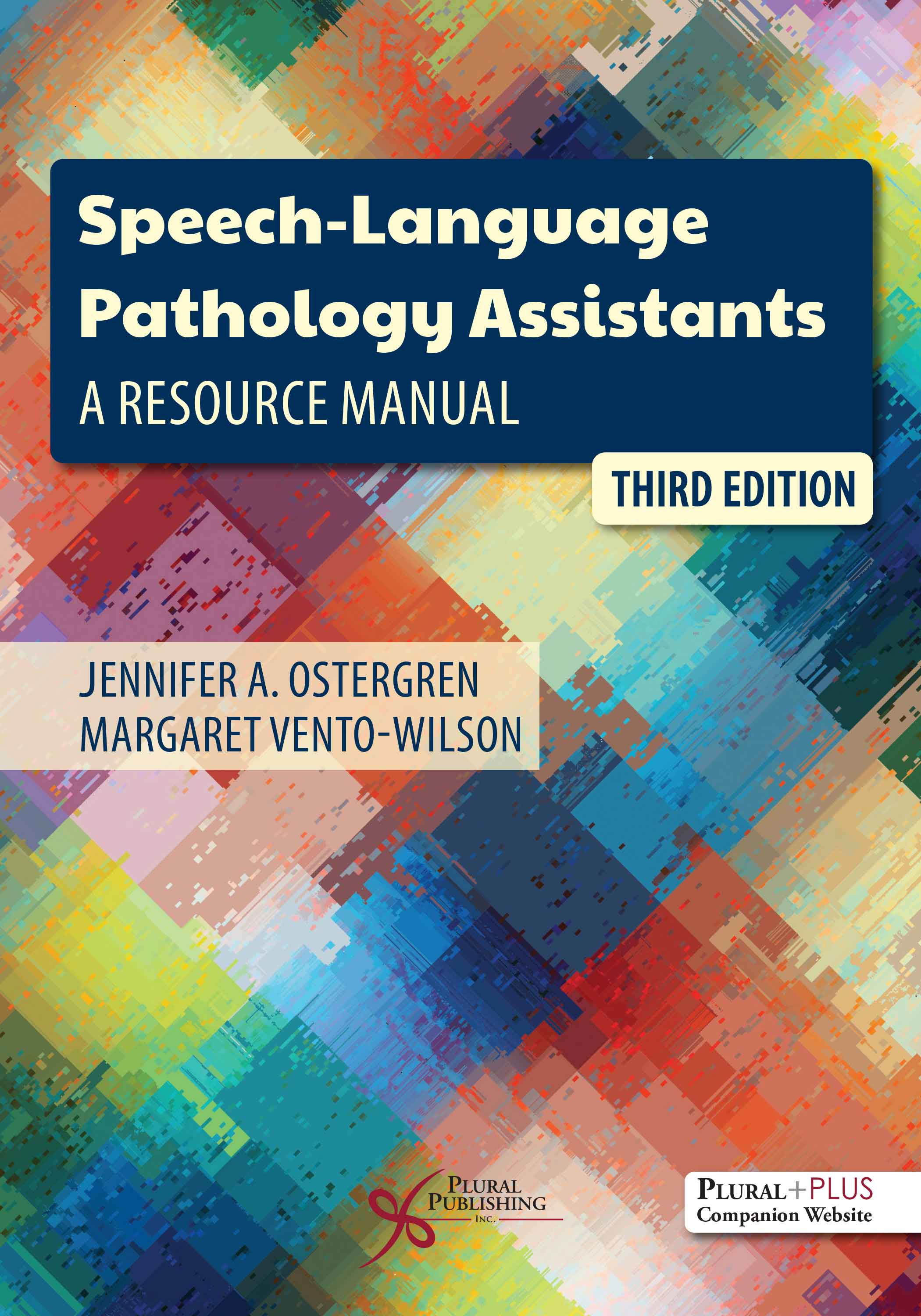
Speech-Language Pathology Assistants: A Resource Manual
Third Edition
Jennifer A. Ostergren, Margaret Vento-Wilson
Details: 612 pages, B&W, Softcover, 7" x 10"
ISBN13: 978-1-63550-415-6
© 2024 | Available
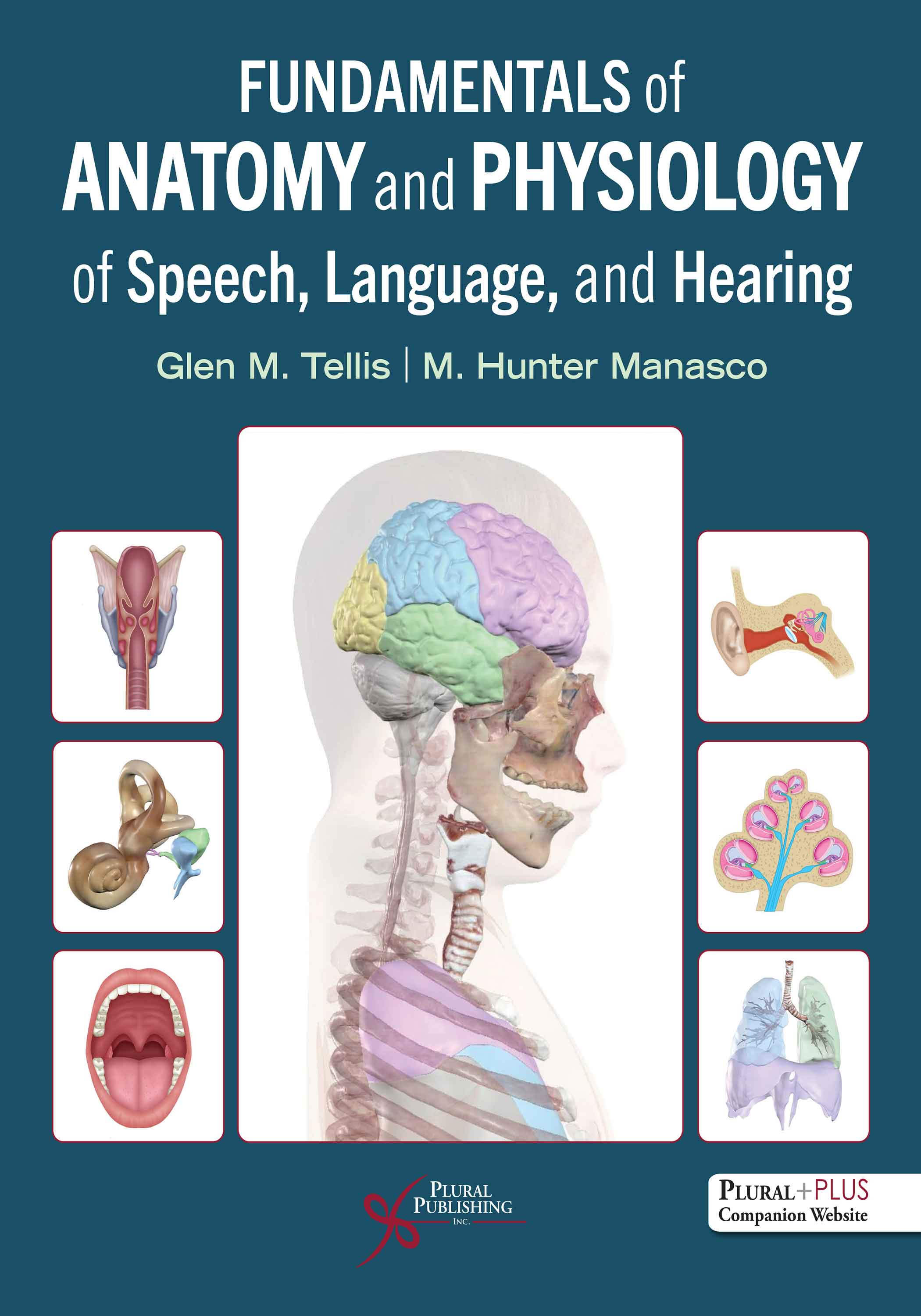
Fundamentals of Anatomy and Physiology of Speech, Language, and Hearing
First Edition
Glen M. Tellis, M. Hunter Manasco
Details: 478 pages, Full Color, Hardcover, 8.5" x 11"
ISBN13: 978-1-63550-720-1
© 2025 | Available


